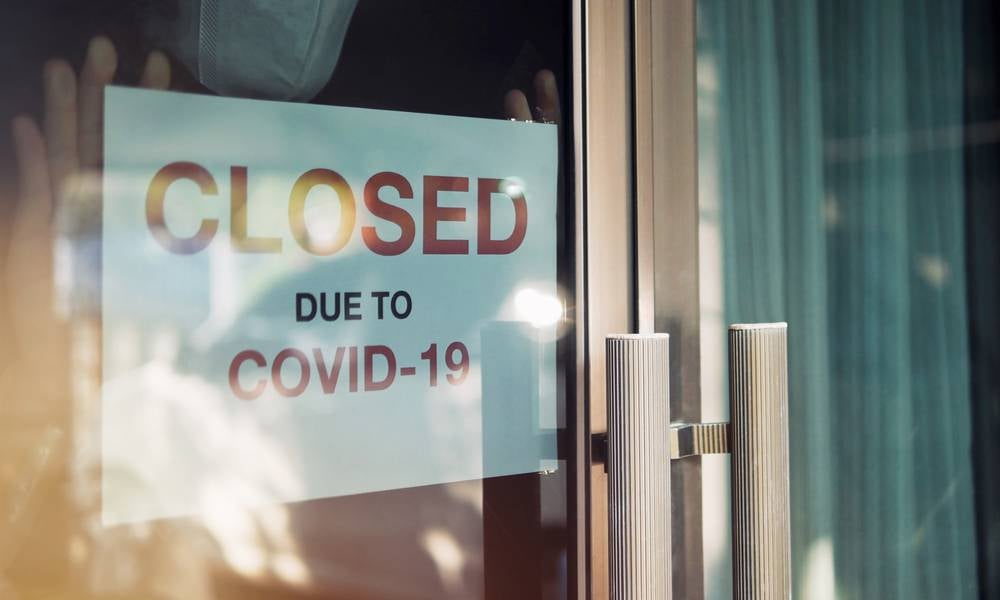Small businesses need a national support plan to survive the COVID-19 pandemic
Small businesses need a national support plan which would simultaneously deliver a shot of confidence for consumers for the remainder of the COVID-19 pandemic, writes UNSW Business School's Richard Holden
The 'shadow lockdown' accompanying the Omicron outbreak should have come as no surprise to Australia’s policymakers. But the type of government support that helped so many individuals and businesses survive the official lockdowns of 2020 and 2021 is absent.
In the face of large case counts, hospitalisations and deaths from Omicron, people voluntarily cut back on economic activity. Why risk going out for a meal or sitting in a theatre while infections are raging?
This effect was quantified as early as mid-2020 by two University of Chicago economists, who calculated (using data from 2.25 million businesses across 110 industries) that nearly 90 per cent of the reduction in economic activity in the US stemmed from voluntary “self-lockdowns”, rather than government-imposed restrictions. In Australia, we can see the effect in consumer confidence plummeting in January 2022 to its lowest level since October 2020 (and the worst January result since 1992).
For many small business owners, the past month has felt like the most difficult period of the pandemic. The single biggest government support measure, the $90 billion JobKeeper wage subsidy scheme, was phased out in March 2021, with most other support winding up by the end of the year. Given small businesses employ more than 5 million Australians – more than 40 per cent of private-sector jobs – how we can help them survive this pandemic now, and if more COVID variants emerge?

The current patchwork of state and federal COVID payments
The following tables summarise the COVID-specific support programs that are still available today.
For individuals, the main support is the federal government’s Pandemic Leave Disaster Payment, which provides up to $1500 for two weeks for individuals who cannot work because of having to isolate, quarantine or care for someone with COVID-19.
Most states and territories also provide a lesser one-off payment to support those who have to isolate but who can’t access the Pandemic Leave Disaster Payment.
Individual support
Pandemic financial support by state and territory, as at 10 February 2022.
Commonwealth
- Pandemic Leave Disaster Payment
Up to $1500 for two weeks if you cannot earn an income because you must isolate, quarantine or care for someone with COVID-19.
More information: Services Australia
ACT
- COVID-19 Hardship Payment
$270 single payment if you miss work because you, or someone you care for, is isolating in compliance with public health orders and cannot get the Pandemic Leave Disaster Payment.
NSW
- COVID-19 Test and Isolate support payment
$320 single payment if you need to self-isolate and cannot work while waiting for a COVID-19 PCR test result and cannot get the Pandemic Leave Disaster Payment.
More information: Service NSW
NT
- No extant territory schemes identified.
Coronavirus NT
Queensland
- No extant state schemes identified.
COVID-19 Queensland
South Australia
- South Australian COVID-19 Cluster Isolation Payment
$300 single payment if you are required to self-isolate (according to SA Health guidelines) and miss work while awaiting a COVID-19 PCR test result, and cannot access the Pandemic Leave Disaster Payment.
More information: SA Government
Tasmania
- Tasmanian Pandemic Isolation Assistance Grant
$750 single payment if you lose earnings due to having to isolate or required to care for a dependant who is a confirmed case or close contact, and cannot get the Pandemic Leave Disaster Payment. - PCR test payment
$250 single payment to help cover lost income or earnings while isolating and waiting for a PCR test result and do not qualify for other support. - Vaccination payment
$250 single payment if you lose income due to getting a COVID-19 vaccination and do not qualify for other support. - Returning quarantine payment
$750 payment for each period of up to seven days of quarantine if directed to quarantine for five to 14 days after returning to Tasmania.
More information: Tasmanian Government
Victoria
- Victorian COVID-19 Test Isolation Payment
$450 single payment if required to self-isolate while you wait for the results of a COVID-19 PCR test, or have to care for a dependant isolating, and cannot get the Pandemic Leave Disaster Payment.
More information: Victorian Government
Western Australia
- WA COVID-19 Test Isolation Payment
$320 single payment if you are directed to isolate while awaiting a COVID-19 test result, are unable to work from home, do not have access to paid leave or other income, and cannot get the Pandemic Leave Disaster Payment.
More information: WA Government
On the business side, the federal government has its SME Recovery Loan Scheme, which guarantees 50 per cent of loan amounts for eligible businesses with turnovers up to $250 million. This scheme is scheduled to run until 30 June 2022.
The states and territories have wound up most of their general business support programs, with what remains targeted at particular interest groups or sectors.
Read more: What are the hidden costs of COVID-19 lockdowns?
Business support
Pandemic financial support by state and territory, as at 10 February 2022.
Commonwealth
- SME Recovery Loan Scheme
Federal government will guarantee 50 per cent of loan amounts for businesses up to $250 million in turnover. Scheme runs till 30 June 2022.
More information: Treasury - Boosting Apprenticeship Commencements
Subsidising 50 per cent of wages, to a maximum of $7000 a quarter, for employing an apprentice between 5 October 2020 and 31 March 2022.
ACT
- COVID-19 Small Business Hardship Scheme
Up to $10,000 to cover costs of selected utilities (gas, water and electricity), commercial rates and commercial vehicle registrations. Available to businesses with an annual turnover of $30,000 to $2 million that have had more than 30 per cent decline in revenue. Scheme extended to 28 February 2022. - Food business registration, outdoor dining permit, and liquor licensees fee waiver
Waivers extended until 30 June 2022. - COVID-19 commercial liquor permit for off-sales
Allowing licensed premises to sell takeaway liquor. Until 31 March 2022. - Payroll tax exemption for apprentices or trainees
Wages paid to apprentices or trainees employed after 1 August 2020 are exempt from payroll tax until 30 June 2022.
More information: ACT government
NSW
- Small business fees and charges rebate
Up to $2000 in rebates for sole traders, small businesses and not-for-profit organisations to offset costs such as food licences, liquor licences, tradesperson licences, event fees, outdoor seating fees, council rates and road tolls for business use.
More information: Service NSW - Alfresco Restart rebate
Up to $5000 rebate for businesses to create or expand outdoor dining areas. Available until 30 April 2022.
More information: Service NSW
NT
- Business Hardship Package
Deferral, reduction or waiver of payments such as payroll tax, utility bills and rates for businesses with a turnover less than $50 million whose revenue has declined 30 per cent or more due to COVID-19.
More information: Business Recovery NT
Queensland
- COVID-19 cleaning rebate
Up to 80 per cent of professional cleaning cost, capped at $10,000, for businesses and not-for-profit organisations listed as an exposure venue by Queensland Health. Available until 30 June 2022.
More information: Business Queensland - Fee waivers and refunds for tourism businesses
A range of fee or rent reductions and waivers are available to tourism businesses operating in national parks, marine parks, recreation areas or state forests, between 1 July 2021 and 30 June 2022.
More information: Business Queensland - Touring Queensland Quick Response Fund
Grants up to $20,000 to arts organisations and businesses to support delivery of touring performances or exhibitions. Scheme closes 31 March 2022.
More information: Business Queensland
South Australia
- Payroll tax deferral
Deferral of payroll tax due from January 2022 to June 2022 for tourism, hospitality, gyms and other eligible businesses affected by trading restrictions in place from 27 December 2021.
More information: Treasury SA
Tasmania
- COVID-19 Business Impact Support Program (Round 2)
Grants of $1000 to $10,000 for businesses losing 30 per cent or more in turnover between 15 January and 14 February 2022.
More information: Treasury SA
Victoria
- Commercial Tenancy Relief Scheme
Rent relief for businesses with an annual turnover up to $10 million whose turnover has dropped at least 30 per cent due to COVID-19. Scheme extended to 15 March 2022.
More information: Victorian Small Business Commission
Western Australia
- Commercial Tenancy Relief Scheme
Rent relief for businesses with an annual turnover up to $10 million whose turnover has dropped at least 30 per cent due to COVID-19. Scheme extended to 15 March 2022.
More information: Victorian Small Business Commission
Most generous are the Northern Territory and Australian Capital Territory governments, which have “business hardship” packages offering rebates to reduce or waive payments such as payroll tax, utilities bills and rates.
New South Wales has a more limited rebate scheme, offering up to $2000 to sole traders, small businesses and not-for-profit organisations to offset costs such as food licences, liquor licences, tradesperson licences, event fees, outdoor seating fees, council rates and road user tolls. It also has (my personal favourite) the Alfresco Restart Rebate, giving up $5000 for restaurants to create or expand their outdoor dining area.
Queensland has a cleaning rebate for businesses and not-for-profit organisations designated exposure sites by Queensland Health. Victoria has a scheme to help commercial tenants cover rent.

Paying to save jobs across NSW
But given how tough small businesses are doing it, many people think these measures aren’t enough.
One of those people is the NSW treasurer, Matt Kean. On January 30 he announced $1 billion in support for businesses with “JobSaver 2.0”, resurrecting the JobSaver program that had subsidised up to 40 per cent of payroll expenses for businesses suffering a 30 per cent fall in turnover due to official lockdowns.
JobSaver 2.0 reimburses businesses (of less than $50 million turnover) 20 per cent of their weekly payroll, up to a cap of $5000, if they have lost 40 per cent of turnover during January. JobSaver had been half funded by the federal government. Kean did not disguise his unhappiness about the federal government refusing to help with JobSaver 2.0, saying: "I was hoping to make this announcement standing beside the Prime Minister today and the Treasurer [Josh] Frydenberg, but they’re not to be found."
Frydenberg, reportedly, did take Kean’s proposal to the prime minister, who in March 2020 had approved $320 billion of fiscal support (equivalent to 16.4 per cent of GDP). But this time, Scott Morrison apparently rejected the idea.

The case for a national plan
This is more than just a question of who pays – the Commonwealth or the states and territories. It’s about what is going to be required to get small businesses, who often have fragile balance sheets, through this stage of the pandemic. One view is the Omicron cases are falling and consumer confidence should pick up, so there’s no need for extra support now.
But it would be rather brave to predict there won’t be further COVID-19 variants and outbreaks. If and when there are, consumers will go back into self-lockdown.
Do we really want more argy-bargy between states and the feds in the future, while consumer confidence plummets and with it small business revenues? A far better solution would be to have an Australia-wide, federally funded support plan triggered by case numbers.
Read more: Innovation set to be biggest challenge for small businesses in 2022
This would provide predictable support for businesses, including those working across state borders, by allowing them to plan, invest and keep hiring workers. And it would deliver a shot of confidence for consumers for the remainder of the pandemic – however long that may be.
The alternative is to stay in a constant crouch, waiting for the next outbreak and hoping some form of government support will arrive in time.
We should be able to do better by our small businesses and the many Australians who work for them.
Richard Holden is a Professor of Economics at UNSW Business School, director of the Economics of Education Knowledge Hub @UNSWBusiness, co-director of the New Economic Policy Initiative, and President-elect of the Academy of the Social Sciences in Australia. His research expertise includes contract theory, law and economics, and political economy. A version of this post first appeared on The Conversation.
